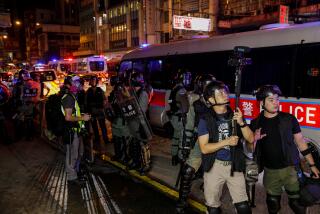Three Britons convicted of plot to blow up planes
- Share via
LONDON AND WASHINGTON — Three young Britons were declared guilty Monday in a London court of planning to blow up transatlantic planes in a spectacularly scaled Al Qaeda terrorist plot that could have killed thousands of people.
A jury in Woolwich Crown Court convicted Abdulla Ahmed Ali, 28, Tanvir Hussain, 28, and Assad Sarwar, 29, of conspiring to murder by setting off liquid bombs smuggled aboard seven North American-bound airliners in sports-drink bottles. Police have said the plan was possibly days from fruition when the men were arrested in August 2006 amid the biggest counter-terrorism investigation in British history.
The plot sparked worldwide changes in airport security, including limits on how much liquid passengers can carry aboard flights.
The verdicts came as a major relief for British law-enforcement and intelligence officials haunted by the failure of a jury to reach a decision on those charges in the first trial a year ago. At that time, the three men were convicted only of conspiracy to murder, without the aircraft element, leaving questions about the government’s portrait of a terrorist threat to air traffic.
“This case reaffirms that we face a real and serious threat from terrorism,” British Home Secretary Alan Johnson said. “This was a particularly complex and daring plot which would have led to a terrible attack resulting in major loss of life.”
But the prosecution’s victory was a partial one. Four other defendants were acquitted of the same charges Monday, and the jury deadlocked over an eighth man, though he was found guilty on a general charge of conspiracy to commit murder.
Ali, Hussain and Sarwar still face sentencing and could receive life in prison.
The case has shocked the public here not only because of the audacity and scale of the plan but because its orchestrators, though of Pakistani descent, were British-born Muslims seduced by violent Islamic radicalism.
Revelation of the plot and its use of liquid-based bombs also threw the airline industry into chaos. For a brief period, all hand luggage was banned on flights out of Britain, and security lines ballooned. Although the restrictions have been eased, a limit on carry-on liquid items remains in force at airports around the world and is unlikely to be relaxed.
In the retrial, which lasted nearly six months, prosecutors drew on 26,000 exhibits -- including evidence gleaned from a bugged house and seized computers -- to detail a plot to bring down the seven airliners on the same day. The organizers allegedly picked out flights from London’s Heathrow Airport to such cities as San Francisco, New York, Washington and Toronto.
Intelligence officials say that the conspirators were directed by Al Qaeda and that their handler was a Pakistani-based militant, Rashid Rauf. The hoped-for high death toll and the targeting of planes by men on suicide missions were clear hallmarks of the network. So was the involvement of another Pakistani-based operative, an explosives expert identified as Abu Ubaida al Masri, who anti-terrorism officials believe masterminded the July 7, 2005, attacks on London’s transport system, in which suicide bombers killed 52 people.
Prosecutors identified defendant Ali as the ringleader of the airliner plot. Investigators found a chilling “martyrdom video” in which the bearded young man berated the West for occupying holy Muslim lands and said the imminent airborne attack would “teach them a lesson they will never forget. . . . You have persisted in trying to humiliate us and kill us and destroy us.”
Sarwar was the group’s chemist, rounding up the ingredients for the hydrogen peroxide-based solution that was to be sneaked onto the planes by injecting it into plastic drinks bottles, prosecutors said. Once over the Atlantic, the attackers were to assemble and set off the makeshift bombs, using batteries to help detonate them.
In his suicide video, Hussain told of his wish to come back and “do it again and again until, you know, people come to their senses and realize . . . don’t mess with the Muslims.”
Defense lawyers argued that the suspects had no intention of blowing up airliners. The videos and explosive material were to be used merely for small-scale publicity stunts to frighten people at airports, lawyers argued.
The specter of last year’s unsuccessful prosecution on the aircraft angle hovered over the new trial from its start in March. In many ways, the credibility of Britain’s counter-terrorism operation, the government’s warnings of the national threat level and even the new security measures imposed on the airline industry were all on the line.
“It was a huge gamble to go for a retrial considering the failure to convict last time,” said Anthony McGee, an analyst at the Royal United Services Institute, a London-based think tank on defense and security. “The first time they brought everybody to trial, it was billed as the strongest [counter-terrorism] case that had been put together, ever.”
A second failure in court would have been “a disaster,” McGee said.
At the retrial, the prosecution introduced new evidence in the form of e-mails circulated among the three guilty men and a handler based in Pakistan. The handler was not named in court, but British and other Western anti-terrorism officials have identified him as Rauf.
In the e-mails, the conspirators used code words -- “after-shave” for the liquid solution, “bus service” for airline, “rapping contest rehearsal” for a planned trial run -- to throw any surveillance agents off the scent of their plot.
In an e-mail on July 25, 2006, an impatient Rauf, whom intelligence officials suspect of acting as a liaison in the London transport bombings, told the plotters to “get a move on” with their operation.
About 10 days later, he sent another e-mail expressing concern that police surveillance, referred to as a “skin infection” in code, might be tightening around the crew.
“How bad is it? Do you always get it when you go outside or is it only sometimes? . . . Do you think you can still open up the shop with this skin problem?” Rauf wrote.
Undaunted, Sarwar replied five days later and mentioned marriage, often a red flag for anti-terrorism investigators because Islamic extremists use the term to indicate a suicide attack.
“Things are going well,” Sarwar wrote. “I haven’t seen the birdy yet, so I havn’t [sic] decided to marry her yet. But I have good hopes for this particular birdy.”
That was the last message of the exchange before police swooped in.
Authorities in Pakistan arrested Rauf as well, but he escaped from custody under suspicious circumstances in late 2007, shortly before his extradition to Britain. He was killed in a U.S. airstrike in Pakistan in November. Masri, the explosives expert, died of disease in early 2008.
The e-mails among the conspirators were not used in the previous trial because electronic intercepts cannot be used in British courts. British authorities later obtained the original e-mails from the records of Internet providers in the U.S., British officials said.
Last year’s failure to convict frustrated intelligence officials and Scotland Yard because of the gap between what they say they discovered and what counts as admissible evidence in court. Investigators and prosecutors also had to weigh what information could be brought out safely in open court against what information could compromise future intelligence-gathering operations.
“It’s the classic debate between securing convictions on an individual basis and giving away what your capabilities are -- or, more importantly, what your capabilities are not,” said McGee, the analyst. “There’s a big body of opinion that says the shrewdest terrorists . . . monitor all of these trials incredibly closely and really learn a lot every time there’s a terrorist trial.”
There was also some anger here over a perceived rush by the U.S. to get Pakistan to arrest Rauf, which forced British authorities to move in on Ali and the others sooner than they wanted, sacrificing more potential evidence.
Prosecutors have not said whether they will seek a retrial for Umar Islam, 31, the man over whom the jury deadlocked on the aircraft component of the charges. Of the remaining four men, one was acquitted entirely in the case. The other three were acquitted of the aircraft charge, but had hung verdicts on the general conspiracy charge, which means they could be tried a third time.
--
rotella@latimes.com
More to Read
Sign up for Essential California
The most important California stories and recommendations in your inbox every morning.
You may occasionally receive promotional content from the Los Angeles Times.











